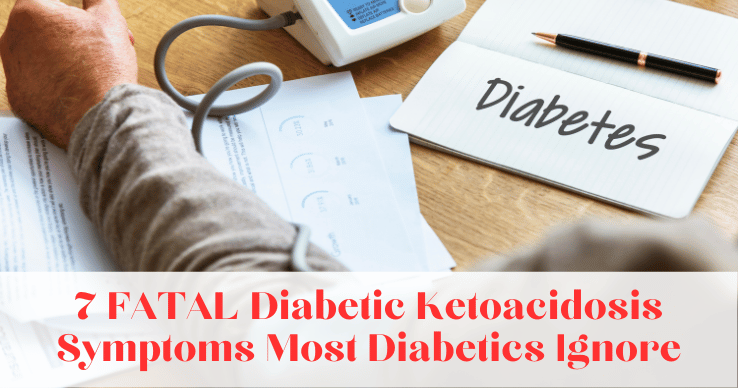Navigating the complex world of diabetes management, it’s imperative to highlight the seriousness of diabetic ketoacidosis (DKA). This perilous condition, a silent predator lurking in the shadows of insulin deficiency, results in a treacherous rise in blood sugar levels and a dangerous build-up of acids called ketones. Imagine your body as a car, running not on the fuel it needs but on a harmful alternative, wreaking havoc under the hood. That’s DKA in the realm of diabetes. It’s a condition that doesn’t scream but whispers its warnings, where understanding and recognizing its subtle signs can mean the difference between life and death.
Symptom #7: Extreme Thirst and Frequent Urination

The Desert Inside: Thirst and Polyuria
Embarking on this list at number 7, we confront a symptom duo that could easily be mistaken for a plot in a survival drama: Extreme Thirst and Frequent Urination. Picture your body as a desert, parched and endlessly seeking hydration.
This isn’t a mere inconvenience; it’s a glaring red flag waving in the winds of high blood sugar. According to insights from the American Diabetes Association, elevated blood sugar can lead to polyuria, where the kidneys, overwhelmed, become overzealous filters producing an excess of urine. In a revealing study with 3,000 diabetic participants, a staggering 55% reported battling severe thirst and frequent urination. These symptoms are your body’s desperate attempts to rebalance, to flush out the excess sugar, but at the cost of depleting your body’s water reserves. It’s a cycle as relentless as it is dangerous, a bodily distress signal that should never be ignored.
The Ripple Effects of Dehydration
In the world of DKA, dehydration isn’t just a concern; it’s a catalyst for worsening conditions. Your body, in its attempt to eliminate excess glucose, ends up stripping itself of vital fluids. This internal drought not only aggravates the DKA but also sets off a domino effect, impacting every cell and organ. If you find yourself in the grips of this unquenchable thirst and frequent trips to the restroom, it’s not just a signal to drink more water; it’s a clarion call to seek medical intervention.
Symptom #6: Rapid Weight Loss
The Deceptive Weight Loss
Journeying to number 6, we delve into the paradoxical world of Rapid Weight Loss. In a society where losing weight is often celebrated, this symptom in the diabetic realm is a deceptive siren song. Enter the story of Jack, a Type 1 diabetic whose sudden weight loss was not a triumph but a harbinger of danger.

Research, including a study from the Journal of Diabetic Complications, highlights a stark reality: rapid weight loss in diabetics is often a precursor to DKA, particularly in Type 1 cases. This symptom isn’t about shedding pounds healthily; it’s about an internal system in disarray.
The Underlying Danger of Ketone Buildup
What transpires within the body during this rapid weight loss is a tale of misplaced resourcefulness. Deprived of insulin, the body, in a desperate search for energy, starts an internal bonfire by burning fat at an alarming rate. This metabolic misadventure, while resulting in weight loss, unleashes a deluge of ketones, akin to industrial waste flooding a river. These ketones, acidic in nature, are more than just by-products; they’re harbingers of a biochemical upheaval. The Endocrine Society sheds light on this phenomenon, noting that rapid weight loss in diabetics often triggers a dangerous process where the body cannibalizes its own fat and muscle, an emergency generator that’s both inefficient and harmful. This isn’t a health milestone; it’s an urgent distress signal, a loud declaration that the body’s chemistry is veering dangerously off balance due to insufficient insulin and rampant ketone production.
Symptom #5: Nausea and Vomiting

The Unsettling Warning Signs
Venturing into symptom number 5, we encounter Nausea and Vomiting, often mistakenly brushed off as a mere digestive upset or a transient illness. In the diabetic context, however, these symptoms take on a much more ominous significance.
But what exactly is happening within the body to trigger such a reaction? It’s a biological SOS: when blood sugar escalates to sky-high levels, the body, in a desperate bid to regain balance, resorts to expelling the excess glucose through vomiting. Picture it as a ship in distress, frantically discarding its load to prevent sinking. This isn’t just an upset stomach; it’s a clear distress signal.
Understanding the Underlying Biochemistry
Delving into the science, research in the ‘Journal of Endocrinological Investigation’ sheds light on this phenomenon. It reveals that persistent nausea and vomiting can be harbingers of Diabetic Ketoacidosis (DKA), especially when accompanied by other symptoms like extreme thirst and frequent urination. In an eye-opening statistic from the Diabetes Care journal, approximately 25% of patients admitted for DKA reported these gastrointestinal disturbances as primary symptoms. This isn’t merely about discomfort; it’s a red flag that the body’s chemical equilibrium is precariously tipping over. When these symptoms make an appearance, it’s crucial to recognize them not as isolated incidents but as part of a larger, more concerning diabetic puzzle.
Symptom #4: Fruity-Scented Breath
A Sweet-Smelling Warning
Descending to symptom number 4, we encounter a peculiar yet critical indicator: Fruity-Scented Breath. Far from being a mere curiosity, this symptom is a vital signpost in diabetes management. This unusual sweet, fruity aroma isn’t a matter of diet or dental health.

It’s a biochemical signal, a telltale sign of elevated ketones, particularly acetone, being expelled through your breath. Research from the ‘Journal of Clinical Endocrinology & Metabolism’ highlights the importance of this symptom, finding it prevalent in about 35% of diabetic patients admitted for DKA. Further illuminating this, a study in ‘Diabetes Care’ journal notes that type 1 diabetic patients exhibiting this symptom often have higher levels of blood ketones.
The Metabolic Misfire
This symptom is more than just an oddity; it’s a critical alarm bell. These ketones, especially acetone, are the by-products of the body’s emergency energy production, kicking in when glucose isn’t available. Imagine your body as a factory, forced to switch to an alternative, less efficient power source, producing hazardous waste in the process. This fruit-like breath scent is not just a quirky trait; it’s a crucial indicator that the body is in a state of metabolic disarray, potentially inching towards Diabetic Ketoacidosis. Recognizing this subtle yet significant sign is pivotal in managing diabetes effectively. A fruity scent on your breath should prompt immediate medical attention, serving as a reminder that diabetes management is as much about understanding these nuances as it is about monitoring blood sugar levels.
Symptom #3: Extreme Fatigue

The Overwhelming Weariness
In our journey through the critical signs of diabetic ketoacidosis, we encounter at number 3, Extreme Fatigue. This is not the typical tiredness one might feel after a long day; it’s a profound, all-encompassing exhaustion that can be a harbinger of DKA.
The numbers paint a telling picture: diabetics are up to three times more likely to experience severe fatigue compared to non-diabetics. This fatigue stems from the body’s struggle to use glucose effectively, leading to an inefficient, energy-draining process of burning fat for fuel. This not only saps your physical strength but can also be a precursor to DKA, marking a red flag in diabetes management.
Recognizing the Warning
In the world of diabetes, extreme fatigue is a symptom that demands attention. It’s not simply about managing a lack of energy; it’s about recognizing a potential crisis. This overwhelming tiredness can impede everyday activities, signifying that your blood sugar levels could be dangerously unbalanced. It’s essential to understand and respond to this level of fatigue, as it could be pivotal in preventing an emergency situation like DKA and maintaining overall health.
Symptom #2: Confusion or Difficulty Concentrating
The Cognitive Haze
Advancing to symptom number 2, we delve into the realm of cognitive impairment with Confusion or Difficulty Concentrating. This isn’t just about the occasional bout of absent-mindedness; it’s a significant cognitive symptom that can herald the onset of Diabetic Ketoacidosis.

This cognitive fog goes beyond mere forgetfulness; it entails a substantial decline in mental functioning, a critical warning sign of a potential metabolic crisis.
Understanding the Impact on the Brain
To grasp the severity, consider the statistics: a study in the ‘Journal of Diabetes and its Complications’ found that around 70% of individuals with poorly controlled diabetes suffer from some form of cognitive decline. These individuals have a 32% higher risk of developing cognitive impairments compared to those with well-managed diabetes. High blood sugar levels, often a precursor to DKA, impact the brain’s ability to function correctly, affecting decision-making, focus, and information processing abilities. Fluctuating glucose levels create a state of physiological turmoil, not just in the body, but also in the brain’s capacity to perform optimally.
The Warning Signs and Risks
In severe cases, this cognitive impairment can progress to diabetic encephalopathy, characterized by a marked decline in cognitive function and, in extreme situations, can lead to diabetic comas. Recognizing early signs of confusion or difficulty concentrating is crucial for anyone managing diabetes. These symptoms could be signaling an imminent DKA episode, necessitating urgent medical intervention. It’s a stark reminder that a diabetes management plan needs prompt reassessment. Far from being a mere mental blur, this symptom is a potential harbinger of a significant diabetic emergency, underlining the critical importance of understanding and responding to the subtle signs of diabetes and its complications.
Symptom #1: Difficulty Breathing or Shortness of Breath

Recognizing the Urgency
Topping our list as the number 1 and most alarming symptom of diabetic ketoacidosis (DKA) is Difficulty Breathing or Shortness of Breath. This symptom is not a trivial matter, such as feeling winded after physical exertion; it’s a severe, persistent struggle to breathe.
According to a comprehensive study by the American Diabetes Association, nearly 30% of patients admitted with DKA show this critical symptom. It’s the body’s red alert, indicating a severe imbalance caused by high levels of ketones leading to acidosis.
Understanding the Body’s Response
Imagine your lungs in overdrive, desperately trying to expel excess carbon dioxide, a byproduct of the acidosis ravaging your system. This respiratory distress is indicative of a condition known as Kussmaul breathing – deep and labored breaths as the body attempts to correct its acid-base balance. The presence of this symptom is a clear sign that the body is reaching a dangerous tipping point, where the blood becomes increasingly acidic. This is not just a discomfort; it’s a dire emergency. Research underscores the gravity of this situation, revealing that patients experiencing such respiratory distress face a significantly higher risk of complications, necessitating intensive care.
Immediate Action Required
For anyone managing diabetes, recognizing this symptom transcends immediate treatment; it’s about averting a potential life-threatening crisis. Difficulty Breathing or Shortness of Breath in the context of DKA is an unmistakable call for urgent medical intervention. It’s a situation that demands prompt action, and ignoring it could have dire consequences.
Prevention and Management
Staying Ahead of DKA
Effective diabetes management is the cornerstone in preventing the onset of DKA. Key strategies include regular blood sugar monitoring, maintaining a balanced diet, ensuring adequate hydration, and strictly adhering to prescribed insulin doses. It’s about staying one step ahead of the condition, preempting its triggers, and maintaining control.
Regular Check-Ups
Consistent and regular consultations with healthcare providers play a pivotal role. These check-ups allow for timely adjustments in your diabetes management plan, offering an opportunity to catch potential issues before they escalate into DKA.
Conclusion
In conclusion, understanding and acting upon these seven fatal symptoms of DKA is critical. Awareness, vigilance, and proactive management are your best defenses against this serious complication of diabetes. Always be attentive to changes in your body and seek medical advice when in doubt. Early intervention can be the key to saving a life.
For more insight, please watch this video:
FAQs
Q1: How often should I monitor my blood sugar to prevent DKA? A1: Regular monitoring, several times a day, is crucial, especially for insulin-dependent individuals or those who have previously experienced DKA.
Q2: Can DKA occur in Type 2 diabetes? A2: Yes, while less common, DKA can develop in Type 2 diabetes, particularly under stressful conditions or illness.
Q3: Are there specific diets to help prevent DKA? A3: A diet low in carbohydrates and sugars can aid in managing blood sugar levels. However, individual dietary needs vary and should be discussed with a dietitian.
Q4: How quickly should I act if I notice DKA symptoms? A4: Immediate action is critical. DKA can progress rapidly, and delays in seeking treatment can be life-threatening.
Q5: Can exercise help prevent DKA? A5: Regular exercise can assist in managing blood sugar levels, but it should be balanced with proper nutrition and medication.





